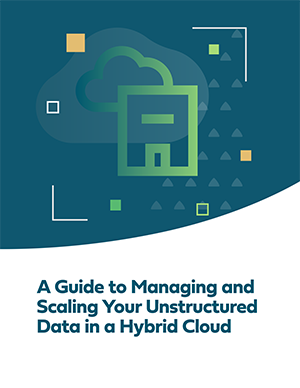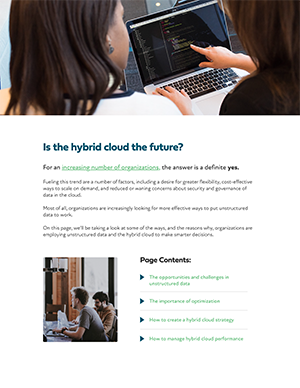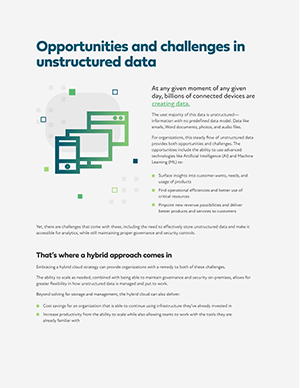Every minute, trillions of bytes of data are being produced. The vast majority of this information is unstructured data—the product of an ever-increasing number of connected devices, photographs and videos, and communications such as emails and social media posts.
By its very definition, unstructured data has no predetermined usage. It’s just an ocean of ones and zeros. But buried within all that information is a potential revolution for how enterprises across industries create products, optimize expenses, and provide better service to customers.
Take, for example, streaming services like Netflix and Amazon Prime Video. These companies are able to mine a steady stream of unstructured data from their hundreds of millions of customers. This data is used to determine everything from what devices are being used to watch their product to the points in a TV episode or film where viewers lose interest. They’re even able to identify where—and for how long—average customers fast-forward through a program.

All this information is then used in the development of future shows and films. And,
while cinema purists no doubt scoff at this type of data-informed creativity, there’s no denying the data-to-content pipelines these companies have installed are effective.
The tools of the unstructured data trade
Coinciding with the rise of unstructured data is the increased adoption of advanced analytics tools like Artificial Intelligence (AI) and Machine Learning (ML).
These technologies, once relegated to the realm of science fiction, are rapidly becoming invaluable tools across industries. By mining unstructured data, enterprises are able to:
- Use predictive analytics to forecast things like supply chain needs, sales trends, and potential disruptions in the market
- Employ AI models to locate efficiencies, streamline logistics, and create better customer experiences
- Experiment with ML models to derive actionable insights and lessons from analytics
While these tools are still in their relative infancy, you’ve probably already seen them in action. Retail websites, for example, are increasingly using chatbots to answer customer questions without the need for costly 24x7 support teams. And powering those chatbots are AI models that continually mine unstructured data to become smarter—and therefore better answer questions—over time.
ML models, meanwhile, are transforming industries such as healthcare, where providers sift through data to flag potential cases of fraud and, in many cases, predict regions where seasonal influenza may hit the hardest.

The challenges of unstructured data
While there are very real opportunities to be found in unstructured data, many enterprises are still unable to actually realize them.
One reason is a lack of talent. Advanced tools like AI and ML require data scientists to concoct models, after all. But even if an enterprise has that kind of expertise in house they may not succeed.
In fact, it’s been estimated that 90% of ML models created by data scientists fail to make it into actual production, and while the numbers are better for AI initiatives, even those face limitations.
What’s the holdup? For one, many enterprises are still relying on technology from the 1990s. That’s a major problem. But even those enterprises at the cutting edge still
encounter roadblocks, and more often than not, those roadblocks are due to one of these four issues:
 1. Storage of unstructured data
1. Storage of unstructured data
Advanced analytics tools require a lot of information in order to be effective. That’s what makes unstructured data so powerful.
But even as the public cloud has made storing data more cost-effective, many enterprises relying on cloud-native tech stacks on premises or at a co-location find anticipating the amount of storage they need to be a challenge.
 2. Data quality
2. Data quality
Results from AI and ML are only as good as the data used to arrive at them. Enterprises without proper processes in place to determine and ensure the quality of their unstructured data will more likely than not fail to achieve liftoff with their advanced analytics efforts.
 3. Data organization
3. Data organization
Yes, unstructured data is by definition messy. But in order for tools like AI and ML to produce results, they need to be able to actually find useful information. A failure to properly organize unstructured data once it’s been captured will only leave AI and ML models to drift aimlessly.
 4. Technical maturity
4. Technical maturity
To effectively capitalize on unstructured data, enterprises need to have a thorough understanding of their own capabilities when it comes to adopting new technologies. Without knowing their technical maturity, any attempts to jump into the advanced analytics game will only lead to false starts and frustration.
Breaking through the roadblocks
So how can you get your enterprise in a position to unlock the opportunities of unstructured data? The key is to have the right infrastructure in place.
For many enterprises, this can be achieved via a hybrid cloud strategy that leverages the power of both on-premises data storage and the cloud.

Via the hybrid cloud, you are able to scale your storage capacity as needed, you are also able to continue using the infrastructure you’ve already invested in, and your teams are able to work with tools they are familiar with.
In addition, the hybrid cloud makes it possible for you to put capabilities in place to actually use your unstructured data. Capabilities that include:
- Data lakes with governance and security protocols in place to make specific data available for specific uses
- Monitoring and reporting tools to provide visibility to workloads running in the cloud
- Ongoing cost monitoring to avoid runaway cloud expenditures
As for scaling on premises, there are a number of tools available to meet your capacity needs. Dell EMC’s Isilon OneFS, for example, is a cost-effective way to scale your on-premises storage as needed and enable data mobility to and from the public cloud.
Getting started with unstructured data
The amount of unstructured data is only going to increase going forward, as more and more connected devices arrive on the scene.
Whether your enterprise is able to capitalize on the potential cost savings, new revenue streams, and better service will depend upon your ability to utilize advanced analytics tools to mine all the information you have available to you.
If you’re ready to start unlocking the value of your unstructured data, reach out to Redapt to get started.


















